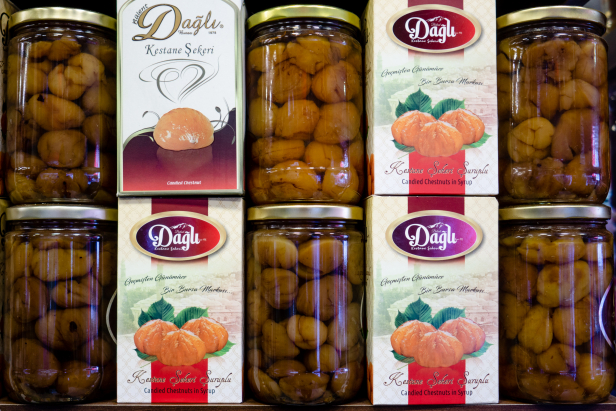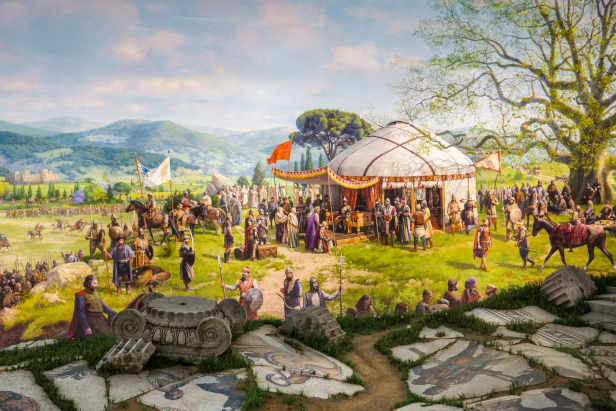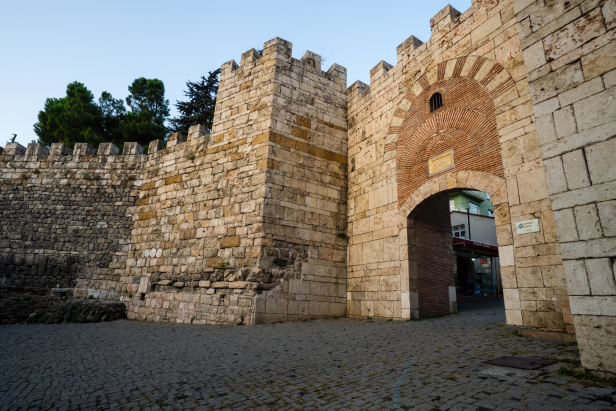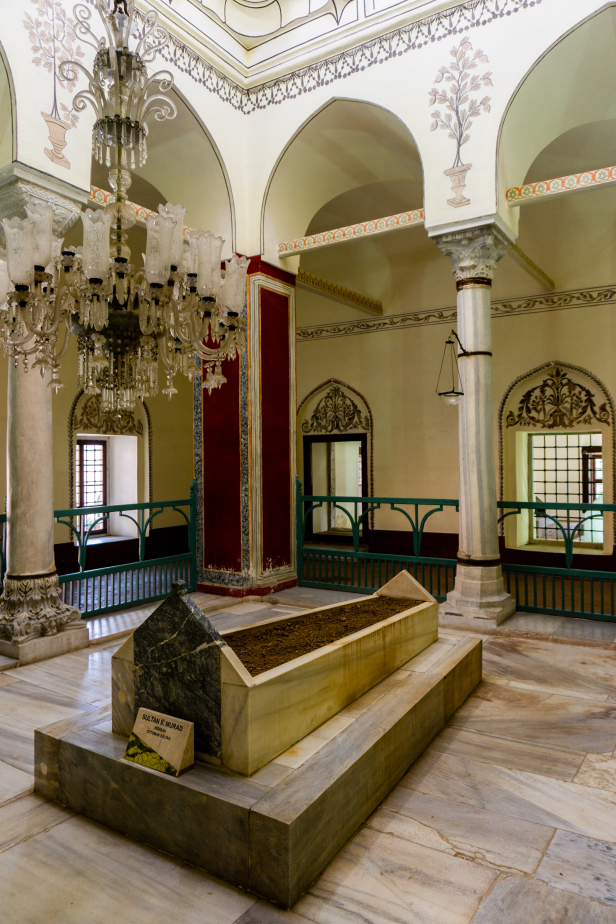The City of Bursa
/ By Josh
Spread out below the green slopes of Uludağ, the city of Bursa is a striking blend of historic splendor, towering trees, excellent food, and bustling streets filled with old world charm and mystery. Though its roots stretch back into the Classical Era and even on into the prehistoric, Bursa is a city that reflects an Ottoman identity like no other city in Turkey. It was here that a relatively small and insignificant kingdom began to flower into the empire that would span three continents and be the defining power of its age.

Bursa is filled with the great building projects of the Ottomans, the grand mosques, ornate tombs, and sprawling markets, all pointing to a culture developing into its own. New architectural styles and artforms evolved out of their Central Asian and Arab roots and formed a new distinct Ottoman Identity.
With so many sights remaining from this historic turning point, Bursa’s old city has been listed as a UNESCO world heritage site.
Bursa has managed to grow and modernize all while keeping much of its historic center intact. Bursa is of Turkey’s large scale industrial centers and home to a number of universities with 56,000 students.
Subscribe to The Art of Wayfaring
The name Bursa is a derivative of the name Prusa, the ancient ruler of the city in the 3rd century BC. While the city has strong roots back into the Classical Period, Bursa always stood in the shadow of Nicea and Nicomedia (now Iznik and Izmit), its nearby neighbour, and doesn’t take a particularly meaningful role in history until the Ottomans made it their capitol following their conquest of the city in 1326.
Under the leadership of the dynasty founding Osman Gazi, the Ottomans laid siege to Bursa for around a decade. By the time the city fell, Osman Gazi had already died, but his heir, Orhan Gazi, finished the task in 1326 and continued to expand his control in the region.
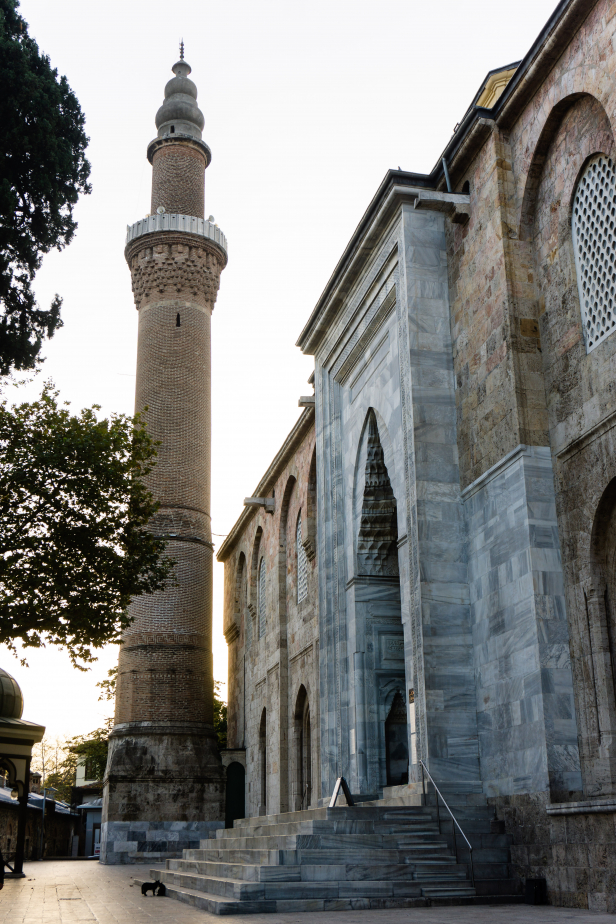
Under the Ottomans Bursa would reach a golden age. The city quickly outgrew the hilltop fortifications and expanded onto the lower slopes. Hans and caravanserai’s were built to accommodate the influx in trade that was attracted to the growing wealth and power of the city.
While Bursa did not remain the Ottoman capital for long, it remained something of a spiritual homeland for the empire. Even after Edirne was made capital, sultans were still buried in Bursa in grand tomb complexes of mosques, schools, Turkish Baths, and hospices. Much of Bursa’s beauty comes from the beautiful combination of these grand tomb complexes set against a background of green mountain slopes. It wasn’t until the conquest of Istanbul in 1453 when the real shift of power finally left Bursa.
What was left is a city that fully encapsulates the early Ottoman Identity. The architecture, scale of the city, and even landscape are so incredibly different from Ottoman Istanbul. Perhaps even more attractive is the fact that Bursa, unlike Istanbul, has evaded the effects of mass tourism, giving visitors an opportunity to have an authentic experience of Ottoman grandeur.
Site List:
The Grand Mosque
Bursa Market District
Green Mosque and Tomb Complex
Tastes of Bursa
Irgandı Bridge
Emir Sultan Complex
Panorama 1326 Conquest Museum
Bursa Castle
Tombs of Osman Gazi and Orhan Gazi
Muradiye Complex
Uludağ Mountain
Yıldırım Complex
Bursa Archaeological Museum
Turkish Baths
Why Visit?
The Grand Mosque of Bursa
(Bursa Ulu Camii)
Cost: Free
One of the most imposing sights of old Bursa is the twenty-domed Grand Mosque commissioned by Sultan Yıldırım Beyazıd. One of the works of Sultan Beyazıd was to expand the borders of Ottoman territory, particularly into Europe. Before going into battle with a crusader army at Nicopolis, Sultan Beyazıd vowed to build twenty mosques if Allah would give him victory. When he won he decided not to build twenty mosques, but a single great mosque of twenty domes.
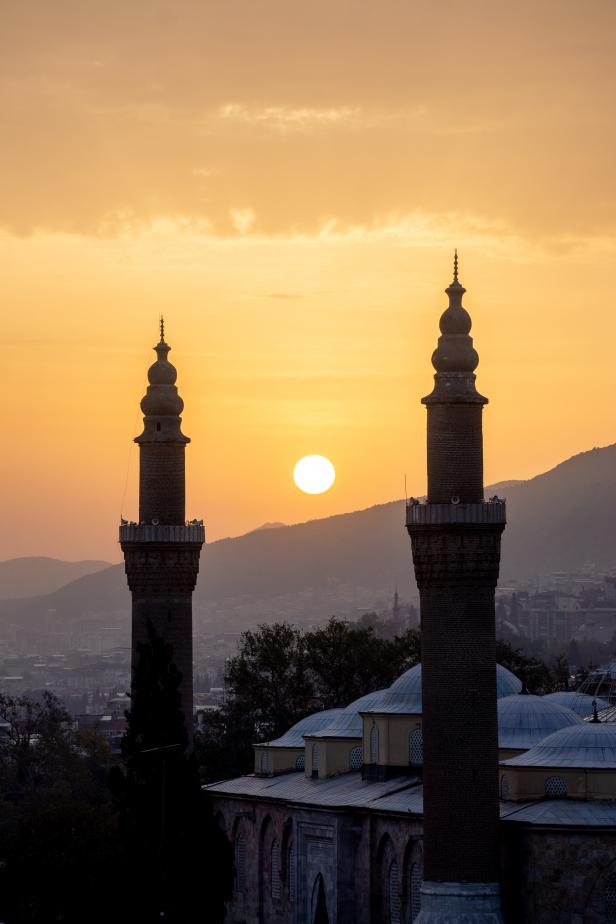
The Grand Mosque of Bursa was the most ambitious Ottoman project to date. Even the Seljuks before had built nothing on this scale in Anatolia. Completed in 1399 it would also be the last mosque built in this “Grand Mosque” style where a grid of equal sized domes would cover a large rectangular room.
The interior of the mosque is a massive airy space, the domes held up by large square pillars throughout the room. The pillars break up the openness somewhat to give a surprising sense of quiet privacy even when there are hundreds of people milling about. The surface of the pillars and walls are covered in fine examples of Arabic calligraphy, some swooping and full of fanciful curves, others stark and geometric, and others made to look like domes and minarets. The calligraphy was not added until a few centuries later, most of it dating from the 18th to early 20th centuries.

A rather unique aspect of the Grand Mosque of Bursa is its interior shadirvan (fountain for ritual washing). Most mosques will have the shadirvan on the exterior, either in a courtyard or along some exterior wall. According to some stories, when Sultan Beyazıd had chosen the site for his great mosque there was still one old woman who refused to sell her property to make way for the project. Eventually she was coerced into selling, but the Sultan deemed it improper for people to perform their prayers on land taken by coercion, and so the fountain was built on the site of the old woman’s house. The fountain that you see today was built in the 19th century.

Above the shadirvan, in the place of a masonry dome is a dome of glass. Originally this space would have been left completely open (this was a more common design in Seljuk mosques i.e. Eşrefoğlu Mosque) allowing light to enter the heart of the expansive mosque interior, making it much brighter than similar mosques such as the Grand Mosque of Edirne. The addition of a glass dome much later was a huge improvement for a city that sees its fair share of rain and snow.
The mihrab, usually the focal point in a mosque, glows with gold paint, though it is surprisingly small and squat considering the grand scale of the mosque.
The mimbar (cone-topped pulpit atop a flight of stairs) holds a rather interesting secret. The structure is made of walnut using complicated joinery instead of nails. While it is beautiful, the most interesting part is hidden in the geometric paneling on the left side. Here you can see different sized protrusions of wood, each representing different parts of our solar system with relative accuracy especially considering the time.
The Market District
(Çarsı Bölgesi)
Cost: Free
As Ottoman Bursa began to eclipse the power and wealth of Byzantine Constantinople, it became a major center of commerce along the Silk Road, connecting it to markets all over Eurasia. To better facilitate this surge in trade, Sultans, nobles, and wealthy merchants commissioned the building of hans (a han, sometimes referred to as a caravanserai is a large fortress-like building used to protect caravans and their goods from theft and raids).
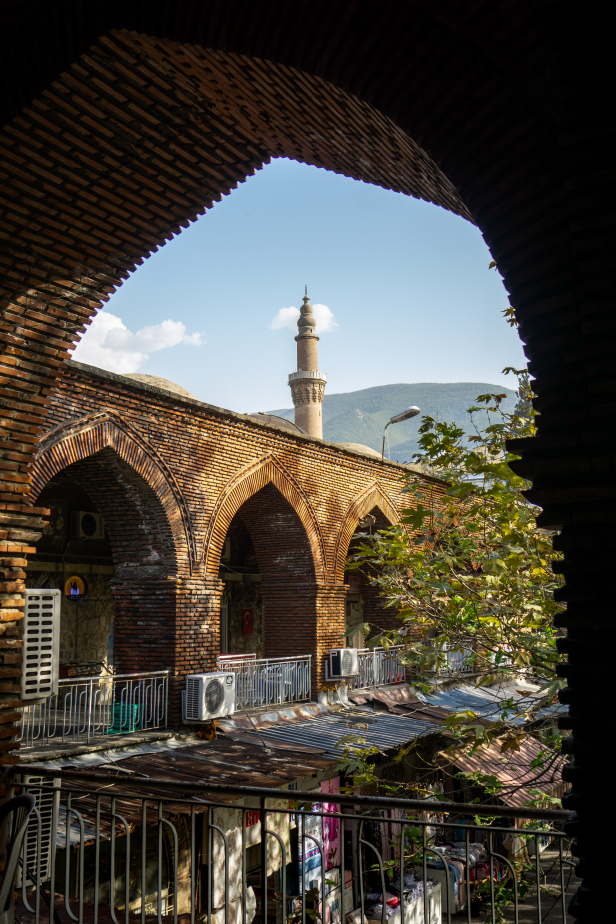
What makes the market district of Bursa so special is how much of this historic neighborhood has continued to be used for its original purpose. The narrow streets and winding alleys are still packed with people buying and selling local fabrics, and all manner of imported goods, and while some shops cater to tourists, tourism hasn’t come to dominate.
The most impressive of these historic hans is Koza Han, built in 1492 with 95 rooms on two levels. In the center there is a beautiful masjid (a small space set aside for prayers) built above a shadirvan (fountain for ablutions) and flanked by a handful of ancient walnut and plain trees. Koza Han takes its name from a particularly valuable Silk Road product: silk worm cocoons (Koza in Turkish). Around the upper gallery you can see historic photos showing great baskets of silk cocoons for auction (as well as a few pictures of Queen Elizabeth II touring the site).
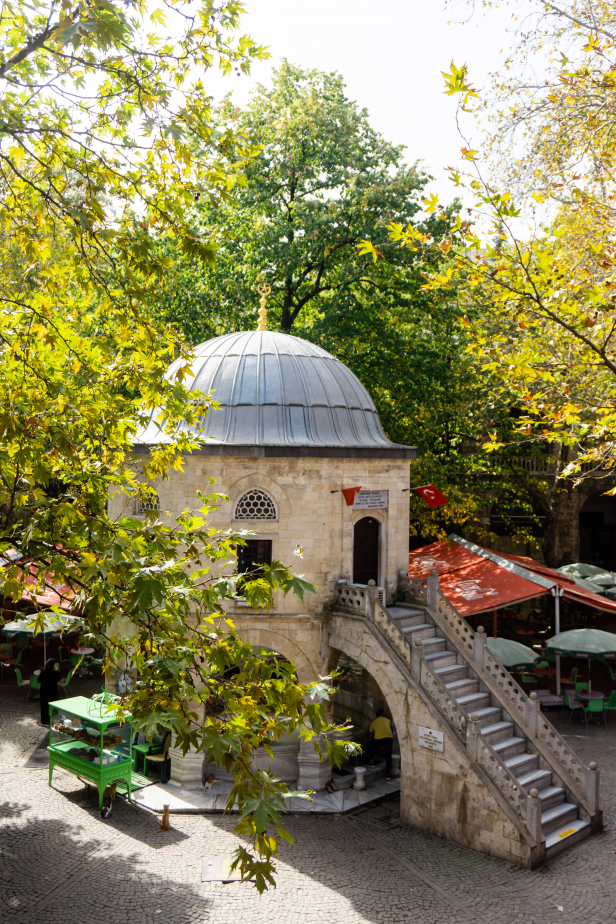
Beyond Koza Han there is Fida Han, İpek Han, Pirinç Han, Emir Han, Geyve Han , and Yıldırım Beyazıd Bedestan to explore. In fact the spaces between these historic buildings have been filled with thousands of shops selling everything from locally made textiles, local produce, locally made knives, hand made brooms, and basically anything else you can imagine.
Subscribe to The Art of Wayfaring
This is also a great place to try some local dishes such as Iskender Kebap or Tahinli Pide or pick up a can of candied chestnuts (see below for more about Bursa’s delicacies).
The Green Mosque and Tomb Complex
(Yeşil Camii ve Türbe Külliysesi)
Cost: Free
One of the truly iconic sights of Bursa, the Green Mosque and Tomb crowns one of the old city’s tree covered hills with domes and spires. Commissioned by Sultan Mehmet Çelebi in 1419, the mosque was completed a couple years after his death in 1421. The mosque and mausoleum capture the shift from the Persian architectural styles into what was to become the Ottoman, blending elements of the two together.

While the marblework and masonry of the complex is quite beautiful, the real beauty is seen in the exquisite tilework that fills both mosque and tomb. The tiles here are among the most beautiful in all the Ottoman Empire.

The mihrab is a massive panel of tiles covered in flowing calligraphy and sharp geometrical patterns. In the mausoleum of Sultan Mehmet Çelebi walls and coffin alike are covered in stunningly complex designs and striking colours. While the complex is associated with the colour “green” blue is actually the more dominant colour, though many sections of blue tiles weren’t added until 1855.

The Green Mosque and Tomb were built as part of a wider complex including a Turkish Bath, and soup kitchen where the sultan himself was said to have come to serve the poor.
The Food of Bursa
Bursa Mutfağı
Cost: Varies
Iskender Kebap
While the majority of Turkey’s most beloved dishes come from South-Eastern cities like Gaziantep, Adana, and Urfa, Iskender Kebap is North-West Turkey’s great contribution to Turkey’s delicious menu.
Iskender Kebap is a dish of shaved donair piled onto a bed of cubed pide bread, and drizzled with a tomato and herb sauce. A large scoop of heavy yoghurt is served on the side and the entire works are drizzled with a pan-full of boiling butter. A green pepper and half tomato lightly grilled over charcoal completes the dish.
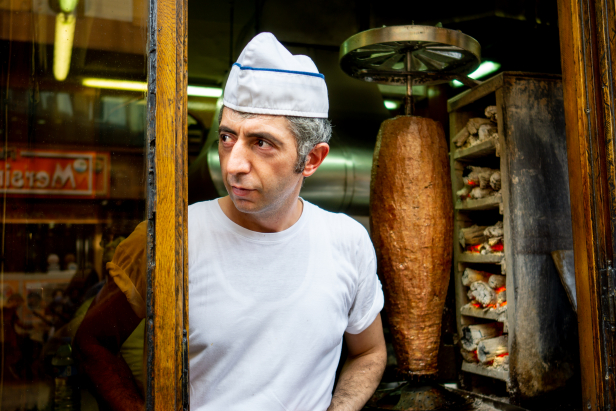
The best places to enjoy Iskender Kebap are:
Kebapçı İskender – This little blue shop right on the main street (Atatürk Street) just East of Koza Han and the above mentioned Grand Mosque is never without a line up out the door and down the street. They only serve Iskender and there is no place more iconic than this.
Iskender Tarihi Ahşap Dükkan – This shop is a little further east from Kebapçı İskender on Ünlü Street. It has an attractive classic interior and, as it has a bit more space, you probably won’t have to wait as long as at Kebapçı İskender. Iskender Tarihi Ahşap Dükkan is just as iconic and their Iskender is absolutely perfect.
Iskender Efendi Konağı – A little ways away from the historic center of the city this restaurant serves incredible Iskender Kebap in a stunning historic mansion in the middle of the Bursa Botanical Gardens (Bursa Botanik Parkı).
Cantık
It would seem that most regions of Turkey have their own variety of Turkish Pide (a canoe-shaped sauceless pizza) and Cantık is Bursa’s. What makes cantık unique is the softer, fluffier bread, and round in shape. Toppings are a blend of minced beef, peppers, onions, and tomatoes, lightly spiced.
Tahinli Pide
Tahinli Pide is basically the dessert version of cantık. Instead of meat, vegetables and spices, the topping is a sweetened sesame paste (tahin in Turkish or tahini in English) baked so that the sugars in the sesame paste become crisp and the bread lightly baked.
Candied Chestnuts
Bursa’s moniker as the Green City comes from its tree filled streets and environs. Ancient plain trees shade the forecourts of mosques, park-like graveyards are filles with cypress, and dominating the city streets, parks, and gardens you’ll find thousand of chestnut trees. The people of Bursa have many ways of eating these chestnuts in various desserts, roasted over coals, and candied. While the roasted chestnuts are a cold season street food, candied chestnuts are served year round.
For more about the amazing foods of Turkey and recipes check out our friend’s site: Jale’s Turkish Delights
Irgandı Bridge
(Irgandı Köprüsü)
Cost: Free
Something of an extension of the old market district, Irgandı Bridge was built as a single span over the Gökdere Stream by Pir Ali in 1442. The bridge is lined on both sides with some 32 small shops, now inhabited by local artists and craftsmen selling touristic pieces.
Emir Sultan Complex
(Emir Sultan Külliyesi)
Cost: Free
Built for the son-in-law of Sultan Beyazıd I in the latter portion of the 14th century, the mosque and tomb have been altered many times over the centuries. The original brick and mortar mosque was expanded in the 16th century from a single dome to a double dome construction like many of Bursa’s other iconic mosques. The interior is decorated in an 18th century Baroque style with painted accents and a subdued marble mihrab.
Panorama 1326 Conquest Museum
(Panorama 1326 Fetih Müzesi)
Cost: 5TL
Built in celebration of the Ottoman conquest of Bursa in 1326, this museum aims to make visitors feel like they’re standing on the field of victory as the Byzantines leave the castle and Sultan Orhan Gazi oversees the take over. A great domed room is painted with a mural so that every direction you look you can see and hear Bursa in 1326. The depiction is rather rosy, without trace of bloodshed or real conflict despite the decade long siege.
In the lower sections of the museum there are other murals and displays showcasing Ottoman clothing during the 14th century and explaining the historic leadup to Sultan Osman Gazi and Orhan Gazi’s success.
Like Istanbul’s 1453 Panorama Museum, Bursa’s museum celebrates a victorious sultan and, at times, comes across as hagiography rather than history.
Bursa Castle
(Bursa Kalesi)
Cost: Free
Little trace remains of the ancient castle of Bursa beyond a handful of repaired portions of wall and a pair of gates. The original walls go back some two thousand years and were destroyed and rebuilt numerous times. While the odd section of massive stone block peak out here and there, the most striking section of wall can be visited by the Fatih and Yerkapı gates, near the tombs of Osman Gazi and Orhan Gazi. The neighborhood within the historic walls has made an attempt at maintaining some historicity though there is little left here worth visiting.
The Tombs of Osman Gazi and Orhan Gazi
(Osman Gazi ve Orhan Gazi Türbeleri)
Cost: Free
According to popular legend, Osman Gazi, founder of the Ottoman dynasty (Osman comes from the Arabic Uthman, which somehow became Ottoman in English), was standing with his son Orhan overseeing the siege of Byzantine Bursa. He pointed to the silver dome of the Bursa’s Orthodox monastery and said to his son, “bury me under this silver dome.” Osman Gazi died before the fall of Bursa but shortly after Orhan Gazi conquered the city in 1326 the church was converted into a tomb for his father. After Orhan’s death in 1362 another portion of the monastery was converted to house his tomb.
Sadly, the original monastery-tomb was destroyed in a violent earthquake in 1855. Some of the only remaining traces of the original building can be seen in the floor of the Orhan Gazi tomb where the paving stones form patterns of twisting shapes and tiny grids of alternating colour. The current mausoleums were built in 1863 in a baroque style with an ornately painted ceiling and wall panels.
The tomb of Osman Gazi has come to receive a great degree of veneration. Throughout the day there is a pair of honour guards dressed in 14th century Ottoman warrior garb standing on either side of the octagonal tomb entrance. Inside there is religious teacher reciting the Quran over the tomb from sunrise till evening.
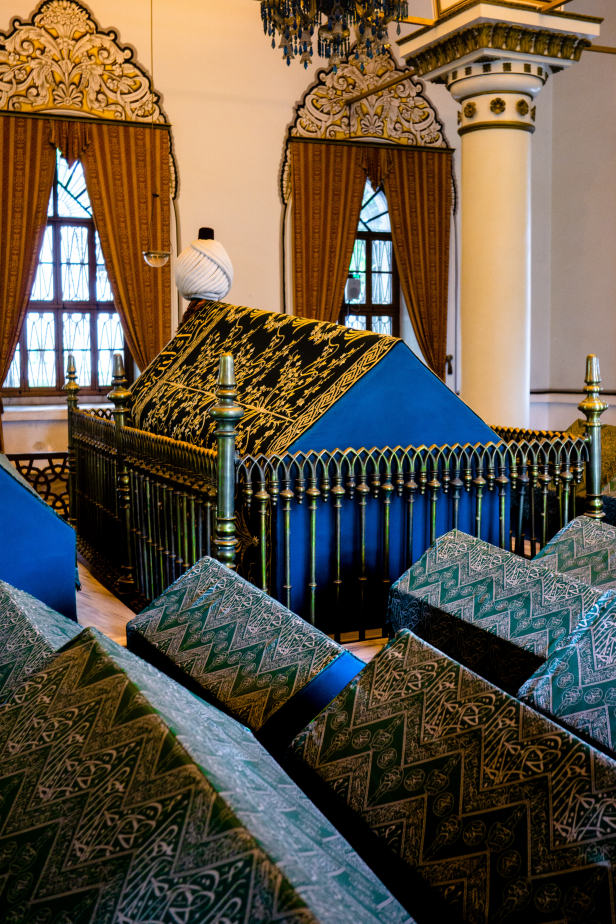
Orhan Gazi’s tomb is larger than that of his fathers though plain by comparison.
Just past the mausoleums is a small park set atop the ancient walls. In the park is a six-storey clock tower dating back to the early 1900’s and built by Sultan Abdulhamit II.
Muradiye Complex
(Muradiye Külliyesi)
Cost: Free
A short walk to the west from the Bursa Castle remains is the Muradiye Complex, one of the largest and most interesting collections of Ottoman royal tombs.
At the center of the complex is the Muradiye Mosque commissioned by Sultan Murad II and completed in 1426, only a few years after the completion of Sultan Mehmet Çelebi’s Green Mosque. The layout of the mosque is similar to the Green Mosque with its pair of large domes and a pair of smaller domes forming wings on the sides, though far more subdued in its decoration.

As with many of Bursa’s historic buildings, the Muradiye Mosque was also damaged by fire and earthquake. The Mihrab (niche denoting direction of prayer) in particular had to be replaced, the current version being a rather out-of-place rococo design set among what are otherwise strong early-Ottoman elements.
The titular tomb of the Muradiye Complex is surprisingly subdued, consisting of a simple marble box set in a small open-air courtyard. The simplicity of this tomb sits in stark contrast to the incredible decadence of the Green Mosque and Tomb built for Murad’s father.
The simplicity of Sultan Murad’s tomb hints at a rather unusual character. Sultan Murad II was a dervish, a type of Islamic Mystic, who preferred to pursue asceticism over the pomp and power of rulership. In fact he even abdicated his throne to his son to pursue his life as a dervish, though, when the kingdom was thrown into civil war he was forced to take up the throne again and restore peace. His tomb is a reflection of his ascetic philosophy.
As sultan he laid the groundworks for the conquest of Constantinople, which his son Sultan Mehmet II would finally realize. Sultan Murad II was the last of the Ottoman rulers buried in Bursa.
Beyond the tomb of Sultan Murad II, there are about a dozen mausoleums scattered around the vast graveyard, each mausoleum usually housing one or two particularly important figures surrounded by the smaller caskets of close relatives. While buried side by side, a great many of these buried here were brothers that murdered each other in their pursuit of the throne, an incredibly brutal backstory to the peaceful beauty of the tombs.
The mausoleums of Şehzade Mustafa, and the shared mausoleums of Şehzade Mustave and Cem Sultan are particularly grand.
Beyond the mosque and tombs, there are a number of madrasahs (mostly used as different museums now), Turkish Baths, and a soup kitchen built by various rulers and nobles.
Uludağ Mountain
(Uludağ)
Cost: Varies depending on how you get there.
Rising nearly 2,000 meters above the city of Bursa, Uludağ (meaning Great Mountain), is Bursa’s stunning backdrop and outdoor playground. In the winter Uludağ is the region’s premier ski destination and thoughout the warmer months its natural beauty attracts hikers to its forests, lakes, and waterfalls.
In ancient times it was known as Mount Olympos of Bythinia, and home to a number of Byzantine Monastic communities.
For access to the alpine area of the mountain, you can drive, take an albeit infrequent bus, or take the gondola and experience the fantastic views of the city and mountain alike.
Yıldırım Complex
(Yıldırım Külliyesi)
Cost: Free
The Yıldırım Complex takes its name from the moniker of Sultan Beyazıd (Bayezid, Beyazit), who was called “The Lightning Bolt” for his incredible speed. The mosque is another attractive example of the early Ottoman design used in the Green Mosque and Muradiye Mosque. The marble work and ornately painted patterns are quite interesting and the mihrab glows gold.
Sultan Beyazıd I was defeated at the Battle of Ankara by Tamerlane, and according to the legends, held captive in a cage. The tomb of Yıldırım Beyazıd is beside the mosque and, though rather plain, it is bright and airy.
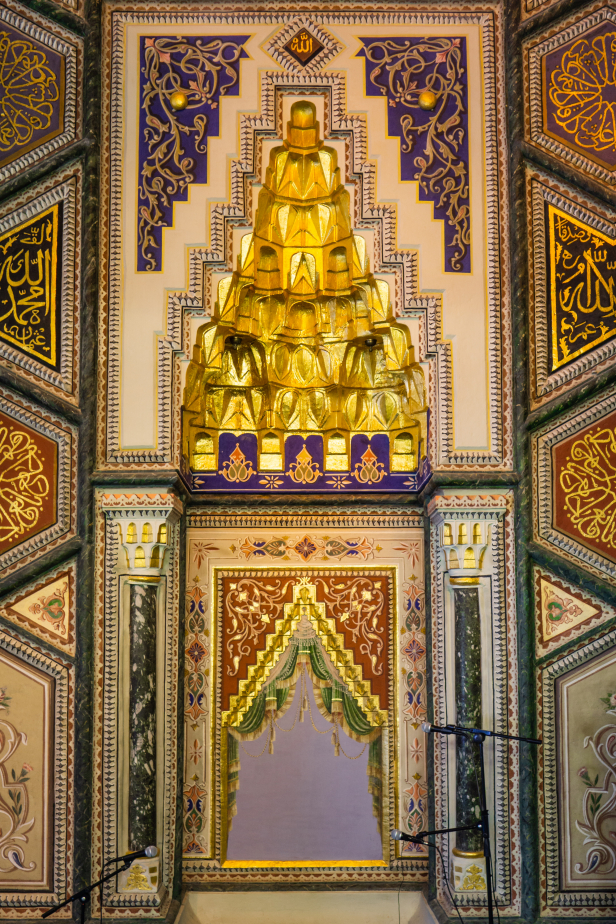
Karagöz Museum
(Karagöz Muzesi)
Cost: Free
The city of Bursa has a strong connection to Karagöz and Hacivat, the two lead characters in Ottoman shadow puppetry. This museum traces this historic connection through the ages with displays of historic puppets and puppet memorabilia.
Bursa Archaeology Museum
(Bursa Arkeoloji Müzesi)
Cost: Free
Bursa’s Archaeology Museum is small considering the size of the city and the presence of numerous cultures and peoples living here for thousands of years. There are some Neolithic remains on display, early classical painted earthenware, numerous statuettes, and a garden full of sarcophagi. The highlights are a statue of Apollo and bust of Athena made of cast bronze.
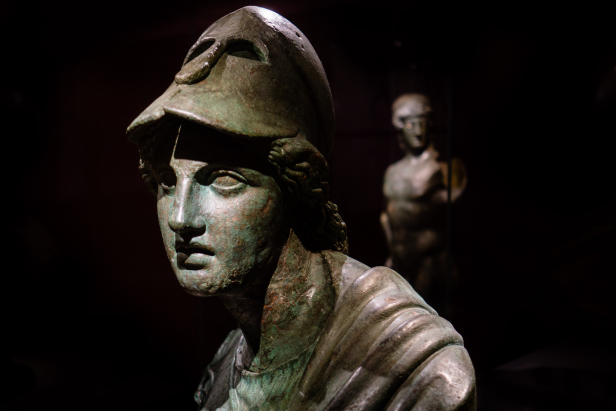
Turkish Baths and Mineral Pools
Hamamlar ve Termallar
Cost: Varies
With natural hotsprings around the city and the gift of some major imperial Ottoman building projects, Bursa is a great place to visit a thermal pool or Turkish Bath. While many of the historic Turkish Baths have been converted into shop space there are still many to choose from. Many of these Turkish Baths and thermal pools date back into the 16th century.
Check out our review of the Çakır Turkish Bath.
How To Get There
General
Between being one of Turkey’s major cities and being situated in Turkey’s crowded north-west, getting to Bursa is very easy. As you could be visiting Bursa from anywhere else these directions are going to stay general.
Car
Highways in and out of Bursa are very good though many of them are toll roads so talk to your rental company about paying tolls before hitting the road. If you’re driving to Bursa from Istanbul you have the option to take a bridge instead of a ferry. The ferry is slow and cheap, the Bridge is fast and expensive. As of writing the price was 147 lira, a lot in local currency but perhaps not bad in your budget. There is a ticket booth to pay for the bridge on the southern side.
Plane
While there is an airport in Bursa it is small, expensive and there are very few flights. Instead we recommend using Istanbul’s Sabiha Gökçen Airport and getting to Bursa using the excellent Burlaş BBBus service. Look for the big yellow busses marked BBBus and Bursa outside of arrivals.
Bus
Without a decent Airport, Bursa has remained a city of bus travel. Busses connecting with all major Turkish cities leave frequently from the city’s central bus terminal in the north of the city at the Anatolium AVM (mall). See the official website for more details.
Ferry
There is service to Bursa by water if you’re coming from Istanbul. There are two companies to choose from, BUDO and IDO. Budo runs from Istanbul to Mudanya , and the IDO runs from many locations in Istanbul to Güzelyalı (Note: you will have to take a bus to Istanbul from either of these places into Bursa proper).
Where To Stay
Bursa is a major city with many hotel options. For cheap, in the middle of the action hotels you’ll see tons of options all around the historic market district. These range from cheap dives to middle of the range three-star options.
Most of the top end hotels such as the Sheraton, Crowne Plaza, and Hilton are a little bit further from the historic heart of the city in modern neighborhoods. These will have pools, restaurants, and, if you grab a taxi you’ll still only be a short drive away from the sights.
For a hotel with a historic thermal pool and Turkish Bath, the Kervansaray is an incredible experience.
Other Tips
Planning on visiting Bursa? Make sure to check out nearby Iznik and the many other sights in the region!
Subscribe to The Art of Wayfaring
Have any tips or info to add? Spot any mistakes? We’d love to hear about it.


